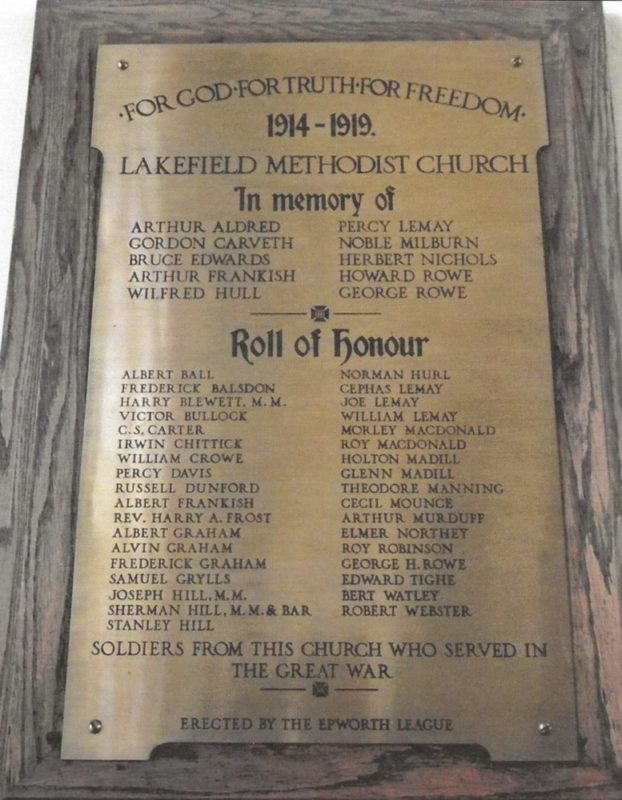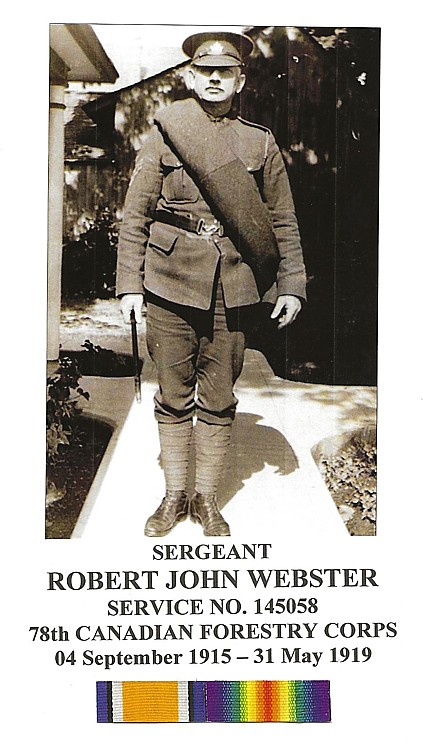MILITARY HISTORY
Private Robert John Webster – 145058 – Active Service (World War I)
On September 4th, 1915 Robert John Webster completed the Attestation Paper for the Canadian Expeditionary Force (CEF). He was 41 years old, when as a married man; he enlisted for the duration of the War. Robert Webster indicated that he was born in Dummer Township, Peterborough County, Ontario, and gave his birth date as November 14th, 1874. The Attestation Paper does not indicate where he was educated or to what level. He indicated that he had served with the 40th Regiment (3 years in the Spanish-American War, and 4 years in the Philippine Rebellion). As far as his Trade or Calling, he lists ”Chief of Police – Lakefield”. Robert was 6′ tall, and had a 42” chest (expanded). He had a fresh complexion, grey eyes, and light brown hair. His medical examination took place September 4th, 1915 in Ottawa, Ontario. In-spite of his age, he had no medical issues or physical limitations, and as such he was deemed fit, for overseas duty with the Canadian Expeditionary Force. His next-of-kin was listed as his wife, Mrs. Effie Webster of Lakefield, Ontario. Robert John Webster signed the Oath and Certificate of Attestation on September 4th, in Ottawa (Rockcliffe), Ontario. The Certificate of Magistrate was signed by the Justice on September 4th, 1915 also at Rockcliffe. Robert John Webster was taken-on-strength with the 77th Battalion, as a Private, and was assigned Regimental Service Number 145058.
The Certificate of Officer Commanding Unit was signed February 2nd, 1916.
Pte. Webster embarked from Halifax on September 25th, 1916. October 1st, 1916, while in transit to England, he was promoted to Acting Company Sergeant Major, and placed on command with the 136th Overseas Battalion. He arrived at Liverpool on October 6th, 1916.
On the same day, the File indicates that ”he reverts to permanent grade of Private, at his own request”. He was also struck-off-strength from the 136th Battalion, on being posted to the 39th Cdn. Res. Bn. He was taken-on-strength with the 39th Battalion, at West Sandling. November 26th, 1916 he was struck-off-strength from the 39th Battalion, and taken-on-strength with the 37th Battalion, at Hastings, on the 27th. December 18th, 1916 transferred to the 1st Canadian Labour Battalion (1st C.L.Bn). December 20th, he is shown taken-on-strength with the 1st CCTB, at Hastings. Research failed to identify this designation. It was also, on this day, that he was appointed Acting Sergeant with pay.
The records indicate, he proceeded Overseas, with the 1st C.L.Bn, from Shoreham, England on January 8th, 1917. He disembarked at Le Havre, in France on January 9th.
Research indicates, that 1st Cdn Labour Battalion were used to provide manpower to the Engineers in the construction of railway lines, road building, tunneling, trench work, excavations, etc., freeing up the younger more fit men to serve on the front.
February 18th, 1917 shows him back in England; he was struck-off-strength on transfer to the CCAC (Canadian Casualty Assembly Centre) on demobilization, at Hastings. Nothing in the Military File indicates that he was wounded, or the circumstances of his return. February 19th, 1917 he was taken-on-strength with the CCD (Canadian Casualty Depot).
May 17th, 1917 once again ”he reverted to permanent grade of Private”. On the same day, he is shown as ”ceases to be attached to the 37th Battalion on transfer to the 3rd CCD”.
July 26th, 1917 Private Webster is shown ”on command from the EORD (Eastern Ontario Regiment Depot) to OT (Officer Training) Battalion, at Seaford”.
September 18th, 1917 ceased to be on command to the OT Battalion, and attached to EORD.
September 27th, 1917 he was struck-off-strength from the EORD, on transfer to the Canadian Forestry Corps, at Sunningdale.
October 3rd, 1917 Acting Sergeant Webster was struck-off-strength from the CFC on posting to the 78th Company of the CFO (Canadian Forestry Overseas), on proceeding Overseas. He disembarked at Le Havre, in France, on the same day. October 10th, 1917 he was appointed Acting Sergeant with pay.
The Canadian Forestry Corps, also referred to as ”the Sawdust Fusilleirs”, was formed November 14th, 1917 when it was realized that vast amounts of wood were needed to support the War effort, on the Western Front. Initially, the idea was to harvest the trees in Canada, and ship them Overseas. But space on Merchant Ships was at a premium (shipping ammunition, men, equipment, etc took precedence), rather than fill the holds with timber, it was decided to use Canadians to cut down the forests of the U.K., and France. Some 35,000 Canadians served in the Corps. The men were used to provide duckboards, shoring timbers, crates, anything that was made of wood for the front line, or railway construction. They even built aerodromes for the expanding Royal Flying Corps. They were also used, as labour units for the Canadian Corps on the front line., performing such duties as: the construction of rail and road systems following the advancing troops, stock piling ammunition, or helping to evacuate wounded from the front.
November 2nd, 1917 he is shown in quarantine with the Mumps.
December 21st, 1917 he rejoined the Unit.
December 13th, 1918 confirmed in the rank of Sergeant.
March 30th, 1919 Sergeant Webster was struck-off-strength CFC on demobilization at Le Havre, France. March 31st, 1919 he was taken-on-strength with the CFC Base Depot, at Sunningdale.
April 4th, 1919 he was struck-off-strength from the CFC Base Depot, and taken-on-strength at MD 3, at Rhyl, Wales, pending embarkation to Canada.
May 21st, 1919 he was struck-off-strength from MD 3, on embarkation to Canada. May 31st, 1919 Sergeant Robert John Webster was discharged from the Canadian Expeditionary Force, in Ottawa, upon demobilization.
The Military File indicates that Sergeant Robert John Webster was not eligible to receive the 1914-15 Star; but that he was eligible to receive the: British War Medal, and the Victory Medal.
According to the Military File, Sergeant Robert John Webster served a total of 3 years, 8 months, and 17 days with the Canadian Expeditionary Force: approximately 1 year in Canada; 11 months, and 13 days in the U.K., and 19 months and 6 days in France.
An excerpt from an article in Maclean’s by Barbara Ameil, September 1996:
”The Military is the single calling in the world with job specifications that include a commitment to die for your nation. What could be more honourable”.
PERSONAL HISTORY
ROBERT JOHN WEBSTER
Robert John Webster was born in Dummer Township on November 14, 1874, the son of Thomas Zacharias Webster and Mary Ann Finnie. He received his education in the local school. In 1898 Robert enlisted and served in the Spanish American War spending four years in the United States. He also served in the Philippine Rebellion. By 1901, Robert was back in Dummer Township, living with his parents and siblings. On October 10, 1906, Robert married Effie McGowan in Hastings, Ontario. She was the daughter of George McGowan and Amelia King. They made their home in Lakefield and in 1911 the family was living at 6 Reid Street in Lakefield.
On September 4, 1915, Robert enlisted to serve his King and Country. He returned home to Lakefield during the summer of 1919. By 1921, they had a family of seven children – William, Meryl, Jean, Hannah, Norma, Nellie and Thomas “Carson” Webster. They were living in Seymour Township and Robert was farming.
It was about 1927 when Robert Webster returned to Lakefield as Chief of Police and performed his duties in a kindly and dignified manner. Robert was a well known and popular citizen of Lakefield. He was also assessor, tax collector, truant officer, sanitary inspector, court crier, and was known to everyone in the district. He was a prominent Orangeman and was a familiar figure in the 12th of July processions held in Central Ontario. Robert and Effie lived on Nelson Street. Robert retired from municipal work in 1931. Robert passed away on October 30, 1936 and Effie died on November 13, 1962; both are buried in Lakefield Cemetery.
Robert John Webster was a member of the Lakefield Methodist Church and is included on a Memorial Plaque which remembers with honour their members who served in the Armed Forces during World War I. This plaque hangs in the Sanctuary of the Lakefield United Church on Regent Street.

FAMILY HISTORY OF ROBERT JOHN WEBSTER
Robert Webster’s paternal grandparents are William Webster born in England in 1807 and Hannah Laing born in Scotland in 1811. They were residing in Otonabee Township in 1836 and had a family of seven children – Ellen, Ann, William, Thomas Z., Hannah, Mary and James Webster. William passed away on October 22, 1884 and Hannah died on May 28, 1896; both are buried in Little Lake Cemetery in Peterborough, ON.
Robert Webster’s maternal grandparents were James Finnie born in Scotland on March 8, 1815 and Jane Lowe born on March 6, 1815. They came to Canada and resided in Douro Township. They had a family of eight children – Jane “Jennie”, Mary Ann, Andrew, John, James, Robert, David and Elizabeth Finnie. James passed away on April 29, 1883 and Jane died on December 12, 1903; both are buried in Lakefield Cemetery.
Robert Webster’s parents were Thomas Zacharias Webster born in Otonabee Township on February 5, 1842 and Mary Ann Finnie born on July 6, 1842. They were married in Otonabee Township on June 30, 1864 and lived in Dummer Township. They had a family of ten children – William, Jane Hannah Verona, James, Ellen, Robert John, David Henry, Thomas Albert, Lorne George and Effie Webster. They later moved to Regent Street in the village of Lakefield. Thomas was the owner and operator of the T.Z. Webster Bakery on Queen Street. Thomas passed away on March 23, 1916 and Mary Ann died on June 27, 1921; both are buried in Lakefield Cemetery.

